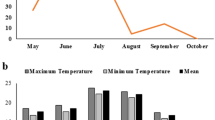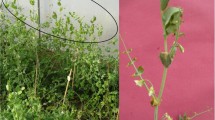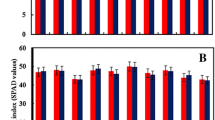Abstract
Heat stress can seriously reduce the tuber yield of potato (Solanum tuberosum). Early maturing cultivars are usually less affected by heat than late cultivars, which is explained by the avoidance of long exposure to summer temperatures due to the short growing time of early maturing cultivars. To determine whether there are other mechanisms involved in heat tolerance of early cultivars, we conducted correlation analysis between field earliness and growth performance of 50 potato cultivars under both heat-stressed (HS, day/night 35 °C/28 °C) and control conditions (CK, day/night 22 °C/18 °C). We classified the 50 cultivars into 8 scales of earliness and grouped them into early, intermediate and late groups based on the information on field plant maturity in Canada. We found that cultivars known to be early in the field grew similar to late cultivars under heat stress in the greenhouse in terms of traits evaluated, such as chlorophyll content and plant height. Compared with late cultivars, the early cultivars did not show any sign of early maturity under heat stress conditions. The HS/CK ratios of chlorophyll content, plant height, and largest tuber weight (tuber size) were all significantly greater in early cultivars than in late cultivars. Tuber size and field earliness were negatively correlated in CK but positively correlated under heat stress. Clearly, in addition to avoidance, other mechanisms (such as pleiotropic effects of earliness genes) were involved in the better performance of early cultivars under heat stress. These results indicated that the cultivars reprogramed their plant maturity and development under heat stress.
Resumen
El agobio térmico puede reducir seriamente el rendimiento de tubérculo en papa (Solanum tuberosum). Las variedades precoces generalmente se afectan menos por el calor que las tardías, lo que se explica porque evitan exposición prolongada a temperaturas del verano, debido al corto tiempo de crecimiento de las variedades precoces. Para determinar si hay otros mecanismos involucrados en la tolerancia al calor en las variedades tempranas, hicimos un análisis de correlación entre lo temprano en el campo y el comportamiento del crecimiento de 50 variedades de papa bajo agobio térmico (HS,día/noche 35 °C/28 °C) y condiciones testigo (CK, día/noche 22 °C/18 °C). Clasificamos las 50 variedades en 8 escalas de precocidad y las agrupamos en tempranas, intermedias y tardías, con base en la información de madurez de la planta en el campo en Canadá. Encontramos que las variedades conocidas por ser tempranas en el campo crecieron de manera similar a las tardías bajo condiciones de agobio térmico en el invernadero en términos de los caracteres evaluados, tales como el contenido de clorofila y la altura de la planta. Al compararse con las variedades tardías, las precoces no mostraron ninguna señal de precocidad de madurez bajo las condiciones de agobio térmico. Las proporciones HS/CK del contenido de clorofila, altura de planta, y el mayor peso de tubérculo (tamaño), todos fueron significativamente mas altos en las variedades tempranas que en las tardías. El tamaño del tubérculo y la precocidad del rendimiento estuvieron correlacionados negativamente en CK, pero positivamente bajo el agobio térmico. Claramente, además de la evasión, estuvieron involucrados otros mecanismos (tales como efectos pleiotrópicos de genes de precocidad) en el mejor comportamiento de las variedades tempranas bajo agobio térmico. Estos resultados indicaron que las variedades reprogramaron su madurez y desarrollo bajo el agobio térmico.




Similar content being viewed by others
References
Barclay G.M., and P. Scott. 1997. Potato varieties in Canada: New Brunswick Department of Agriculture and Rural Development, Canada (ISBN 0-888-38-834-9).
Demirel, U., S. Çaliskan, C. Yavuz, I. Tindas, Z. Polgar, Z. Vaszily, I. Cernak, and M.E. Çaliskan. 2017. Assessment of morphophysiological traits for selection of heat-tolerant potato genotypes. Turkish Journal of Agriculture and Forestry 41: 218–232.
Gawronska, H., M.K. Thornton, and R.B. Dwelle. 1992. Influence of heat stress on dry matter production and photo-assimilate partitioning by four potato clones. American Potato Journal 69: 653–665.
Khedher, M.B., and E.E. Ewing. 1985. Growth analyses of eleven potato cultivars grown in the greenhouse under long photoperiods with and without heat stress. American Potato Journal 62: 537–554.
Kim, Y.U., B.S. Seo, D.H. Choi, H.Y. Ban, and B.W. Lee. 2017. Impact of high temperatures on the marketable tuber yield and related traits of potato. European Journal of Agronomy 89: 46–52.
Krantz, F. 1938. Maturity of potato seedlings in the greenhouse and their later behavior in the field. American Potato Journal 15: 153–157.
Levy, D. 1986. Genotypic variation in the response of potatoes (Solanum tuberosum L.) to high ambient temperatures and water deficit. Field Crops Research 15: 85–96.
Levy, D., and R.E. Veilleux. 2007. Adaptation of potato to high temperatures and salinity-a review. American Journal of Potato Research 84: 487–506.
Levy, D., E. Kastenbaum, and Y. Itzhak. 1991. Evaluation of parents and selection for heat tolerance in the early generations of a potato (Solanum tuberosum L.) breeding program. Theoretical and Applied Genetics 82: 130–136.
Marinus, J., and K. Bodlaender. 1975. Response of some potato varieties to temperature. Potato Research 18: 189–204.
Menzel, C. 1985. Tuberization in potato at high temperatures: Interaction between temperature and irradiance. Annals of Botany 55: 35–39.
Midmore, D.J. 1984. Potato (Solanum spp.) in the hot tropics I. soil temperature effects on emergence, plant development and yield. Field Crops Research 8: 255–271.
Randeni, G., and K. Caesar. 1986. Effect of soil temperature on the carbohydrate status in the potato plant (S. tuberosum L.). Journal of Agronomy and Crop Science 156: 217–224.
Rasco, E.T., R.L. Plaisted, and E.E. Ewing. 1980. Photoperiod response and earliness of S. tuberosum ssp. andigena after six cycles of recurrent selection for adaptation to long days. American Potato Journal 57: 435–447.
Rykaczewska, K. 2015. The effect of high temperature occurring in subsequent stages of plant development on potato yield and tuber physiological defects. American Journal of Potato Research 92: 339–349.
Struik, P.C. 2007. Responses of the potato plant to temperature, 367–393. Potato Biology and Biotechnology: Elsevier.
Tang, R., W. Zhu, X. Song, X. Lin, J. Cai, M. Wang, and Q. Yang. 2016. Genome-wide identification and function analyses of heat shock transcription factors in potato. Frontiers in Plant Science 7: 490.
Tang R., S. Niu, G. Zhang, G. Chen, M. Haroon, Q. Yang, O.P. Rajora, and X.-Q. Li. 2018. Physiological and growth responses of potato cultivars to heat stress. Botany 96: 897-912.https://doi.org/10.1139/cjb-2018-0125.
Wang, L., Q. Hua, Y. Ma, G. Hu, and Y. Qin. 2017. Comparative transcriptome analyses of a late-maturing mandarin mutant and its original cultivar reveals gene expression profiling associated with citrus fruit maturation. PeerJ 2017: e3343.
Wolf, S., A. Marani, and J. Rudich. 1990. Effects of temperature and photoperiod on assimilate partitioning in potato plants. Annals of Botany 66: 513–520.
Acknowledgments
This research was supported by A-base funding of Agriculture and Agri-Food Canada (to XQL). We thank the China Scholarship Council for its support to GDZ and RT, Muhammad Haroon and Lana Nolan for their general support during the preparation of this manuscript, the reviewers for their constructive and valuable comments, and John Gillan and the entire AAFC Fredericton greenhouse management team for taking care of the plants.
Author information
Authors and Affiliations
Corresponding authors
Rights and permissions
About this article
Cite this article
Zhang, G., Tang, R., Niu, S. et al. Effects of Earliness on Heat Stress Tolerance in Fifty Potato Cultivars. Am. J. Potato Res. 97, 23–32 (2020). https://doi.org/10.1007/s12230-019-09740-9
Published:
Issue Date:
DOI: https://doi.org/10.1007/s12230-019-09740-9




